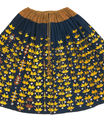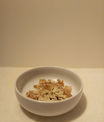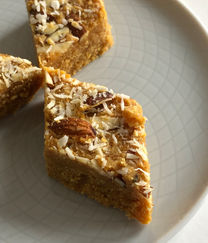
Gardens & Plants
Living History
Objects
from Public & Private Collections
Synesthesia
Perfume & Flavour Translations
The Process
Notes between the perfumer and historian
June - August 2021
Nicolas:
What I like in this painting 'Kamod Ragini' is the obvious intentionality that has gone into the depiction of fragrant plants among which the nāyika/rāginī has set up her phūlõ kī sej - keora, plumeria, and pink oleander (while many oleander varieties are not fragrant, the ones that are have a distinct rich honey scent). A banana and a champaka tree are in the background; jasmine makes sense as part of the flowers laid out; I would really keep the keora prominently, too, though, because it appears so deliberately in the painting, surrounding the trysting spot she has laid out, and it is connected to the moist/ swampy/ wild habitat. Based on the descriptions of gardens and poetic references as well as perfumery recipes I have read, I suspect that keora/ ketaki used to be a much more prominent and coveted feature of the smellscape (rather than perhaps mainly being a biryani flavoring as it is for many today).
As for the time, it is definitely supposed to be dusk. The nāyikā is the generic (romantic) heroine of classical Sanskrit/Braj/Avadhi/etc. literature; in rāgamāla paintings like these and genre scene corresponding to poetry or literary manuals (Rasikapriya, etc.) she is also often identified implicitly or explicitly with Radha. The bed of flowers is a fairly common trope, both in poetry and in painted scenes of woodland trysts or, as here, the anticipation of them.

Bharti:
The floral facets burst out to me in this painting. At your suggestion, the perfume features kewra as its central motif. The flower-bed the 'Ragini' figure has delicately arranged directs my choice of ingredients: frangipani, gardenia, champaca, tuberose, parijat, ylang ylang and jasmine buds.
Additionally, castoreum musk, peru balsam resin + butyl phenyl acetate supplant a slight ripe banana note.
Late in the process I thought of adding Parijat-absolute as it blends so beautifully with the central kewra theme. While not depicted in the painting, it is possible to imagine its fragrant presence in this twilight scene.
Bharti:
While I think about the Edible Perfume, would you like to pick another painting to discuss? We haven't selected one with monsoon clouds rolling in.
Nicolas:
The last painting in our Ragini cluster Apparition of a Tree Spirit during Worship (c. 1725) depicts an amla tree...that might work for the edible component.
Nicolas:
I love this painting, but the rain is only in the offing here, and the subject matter is rather somber - here is the description from the museum:
“The heroine in the doorway is waiting for her husband to return, but he is delayed, and ominous monsoon clouds gather in the distance. The pomegranate tree in her garden has ripe fruits replete with seeds and bright red juices, suggestive of her fertility, but a crow is perched there. The sound of a crow’s voice is an unlucky omen, and this further compounds her anxiety.
Depictions of tense, relatable situations were made to elicit empathy in the viewer and emotions that heightened the pleasure of viewing and savoring paintings.”
Augury of the Crow (Vasakasajja Nayika), c. 1800
Northern India, Himachal Pradesh, Pahari Kingdom of Kangra
Color on paper, Overall: 21.4 x 14.5 cm (8 7/16 x 5 11/16 in.)
Bharti:
This painting and its mood is certainly challenging to translate to scent. I think the question is how does one convey an ominous feeling/ anxiety through a smell? Joy, spring-summer seasons, pleasure, abundance - yes - because audiences are broadly clued into (positive) emotions that citrus, rose and saffron prompt.
Can one communicate an anxious sensation to a general audience through a singular smell or a series of smells? This is where smell and scent get slippery as olfactory associations are unique to each individual. A seemingly pleasant odour can trigger the memory of a traumatic event in another.
Uzair Siddiqui (Sound Designer of our Bagh):
The perfect anxious sound for this painting is in Raag Patdeep “Sajan bin phoole birma, ja re kaaga un ko le aa".
Bharti:
I've been thinking of a way to convey Ragini's love, longing, madness and tears as she searches for her lover. An essay I read somewhere delved into the metaphysical subtext embedded in these Ragini paintings - She is almost always depicted alone, carrying a musical instrument, with a pair of peacocks. The "Krishna" figure, her lover, appears but in peacock form; missing this, she continues her search, her yearning magnified.
Taking frankincense resin 'tears' as inspiration, I find that candied amla/ gooseberry offers an approximation in shape, form and colour. Pieces of amla candy are dusted in sugar prepared with kewra essence, CO2 extracts of jasmine sambac, marigold, amla, curry leaf, palmarosa + saffron extract with dehydrated lemongrass and pineapple powder. A tiny piece of this candy together with its 'pineapple-dust' is to be brewed with white tea included in Synesthesia Box No. 5.
Sour, tart, sweet, you can now taste Ragini's sense of longing against a lush floral backdrop.
You have the latest samples of all synesthesia components.
Nicolas:
This perfume is the most startling of the project when you first open or apply it, because the fragrance of kewra is so distinctive, and nowadays so rarely used in perfumes. It is sweet and floral, and for a while stands on its own, before gradually being joined by other floral and somewhat woody notes that make the scent become more complex and sharp, the almost cloying sweetness of the kewra tempered by the plethora of other flowers depicted in the painting.
There is a hint of the warm honey scent of oleander, then a whiff of the ‘Hawaiian Tropic’ spicy-sweetness of plumeria, and so on, altogether evoking the exceptionally rich olfactory environment imagined in the corresponding painting, as well as the sense of expectant tension encoded in that image. The accompanying edible perfume adds a fresh, acidic contrast in the form of amla, yet once again embedded in a particularly warm sweetness.
A note on the Bagh-i Babur soap created for this project:
Before one even uses it, the soap stuns with its distinctive appearance. Shaped like an octagonal marble pool filled with crystalline blue water like the ones depicted in many sixteenth- and seventeenth-century Mughal paintings of gardens, it is an exquisitely beautiful object, somehow simultaneously intricate and minimalist. In fact, you got increasingly annoyed with me because I was so reluctant to actually begin using the soap and thereby destroy its perfect shape. The scent is subtle yet pervasive; it is not overwhelming or cloying when one smells the soap itself yet gently perfumes the whole room. There is a luxuriant sandal note to it, but underlaid with a briny quality that conveys warmth and a peculiar sense of cleanness and freshness.








































































































